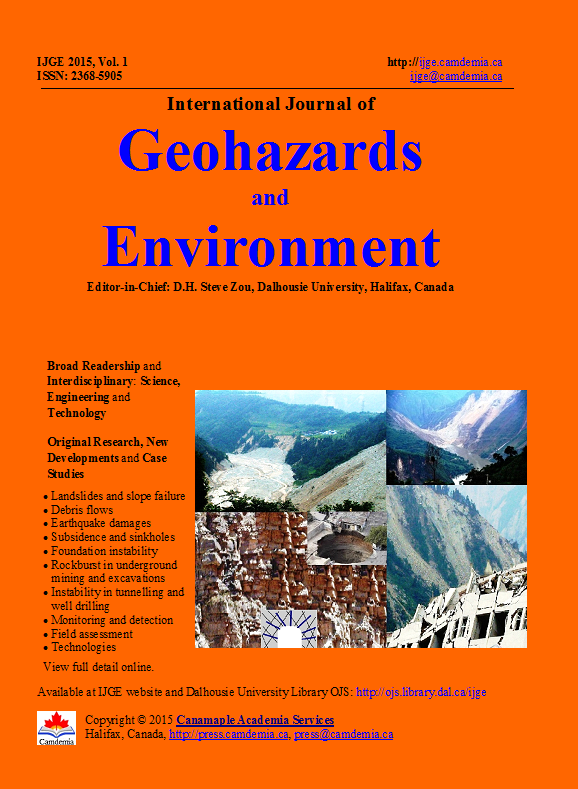Clustering of Large Bedrock Landslides and Recurrent Slope Failure: Implications for Land Seismic Hazard Assessment of the Tien Shan - Djungaria Region
DOI:
https://doi.org/10.15273/ijge.2015.03.014Abstract
Spatial distribution of bedrock landslides in the Tien Shan - Djungaria mountain system is analyzed based on an inventory including more than 700 features, most of which are prehistoric and exceed 106 m3 in volume. They often concentrate within limited areas several tens of kilometres in size, forming clusters divided by areas without or with very rare same-size slope failures. Two main types of landslide clusters are exemplified by case studies from the Chinese and Kazakh parts of this mountain system: those that have one giant feature surrounded by numerous much smaller landslides and those that include several more or less same-size features. Though no data about ages of slope failures that formed these clusters are available, in some cases simultaneity of their formation can be assumed with reasonable confidence. Besides, evidence of recurrent slope failure within these areas is presented. Considering arid climate of the region and limited glaciation, large earthquakes are the most likely trigger of such spatially and temporally localized slope failures, though additional studies are necessary to prove this assumption. In any case landslide and, likely, seismic hazard of such zones seem to be higher than that of the surrounding rockslide-free areas.Downloads
Issue
Section
License
Copyright, Terms and Conditions
The International Journal of Geohazards and Environment (the Journal) is published by Canamaple Academia Services (the Publisher) online with open access, under a Creative Commons Attribution-Noncommercial license (CC-BY-NC) (http://creativecommons.org/licenses/by-nc/4.0/). Authors (the Authors) submitting papers (the Work) for publication in the Journal automatically agree to the following terms and conditions.
1. Under the license (CC-BY-NC), Authors give permission for others to share and reuse the Work, as long as the original source and author(s) are properly cited (i.e. a complete bibliographic citation and link to the Journal website) and the material is not used for commercial purposes. Any sharing or reuse must however indicate the original CC-BY-NC license terms of the work.
2. Authors transfer and assign to the Publisher all copyright in and to the Work. However Authors retain all proprietary rights except the copyright, related to the Work and also retain the rights a) to use, reproduce, distribute, and publicly display the Work in any medium in connection with the Authors‘ academic and professional activities, such as teaching, presentations and lectures, b) to create derivative works from the Work and to make full use of the Work in future research and publications, c) to authorize others to make any non-commercial use of the Work, d) to make both the pre-published and final-published versions available online in institutional and/or disciplinary repositories or on their own websites with a citation and link to the original paper published in the Journal.
3. Authors warrant that the Work is their original work, it is not copied from anywhere or anyone else, they are totally responsible for the authenticity, originality, validity and accuracy, and the facts and views are their own, that the Work contains no matter which is defamatory or infringes any literary or proprietary rights, intellectual property rights, or any rights of privacy, and that the Work has not been simultaneously submitted to any other journals or publishers. Authors further agree that their manuscripts whether accepted or rejected will not be returned and the rejected manuscripts will be disposed at the journal editor's discretion.
Disclaimer: The Publisher, the Journal and the editors accept no responsibility for statements or opinions expressed by authors. Use of information and materials in the Journal is the sole responsibility of users.


